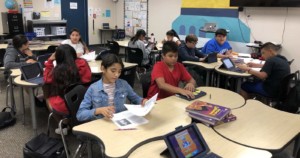Reading Curriculum: Critical Thinking & Creativity for Understanding

By Liam Bayer
As teachers, we struggle with the mundane repetition of the reading process that we involve our students in given many of the current curricula that are available. In some instances, we may supplement that curriculum with a book that we believe our students will enjoy, many of which are recommended by the students or that we see them reading every day once their “work” is done. We then give the students a study guide and assign a chapter to read each day, and may even give them the option to complete a few short answer questions in their reading journal.
In this process, we are trying to help students understand a story that they can already relate to. How can we enhance this method and create a reading curriculum around stories that students connect with, and enhance it by incorporating all of the essential literacy skills, improving critical thinking skills, using the most advanced learning theory, and extending the experience by broadening its scope with creativity? Most importantly, how can we create life-long readers?
Why do we need a more comprehensive reading curriculum?
It’s important for us to create a more rigorous reading curriculum in order to increase a student’s ability to connect to a story. Students in U.S. schools do not perform well in interpreting complex information and analyzing character traits, which highlights the need for increased literacy instruction targeting each. The problem in reading classrooms is that students are not learning how to think critically.
Critical thinking is a higher order thought process that is focused and logical and its polar opposite is creativity, an uninhibited and unpredictable way of thinking. In order for critical thought to take place, creativity has to be used as well, and vice versa. For example, for a student to understand a new piece of information the student has to create a new construct in the mind. In order for students to connect to stories they need to know how to think critically and be creative. The obstacle is that there is no comprehensive approach to teaching critical thinking and creativity that is based upon learning theory.
Teaching critical thinking and creativity
A few years ago, I took the opportunity to create a reading curriculum that was based on critical thinking and creativity and that was both comprehensive and research based. Research tells us that there are five main curriculum features crucial to advancing critical thinking and creativity in reading classrooms – meta-cognitive skills, graphic organizers, brainstorming and outlining, teacher-led conferences, and drawing. The main component that enhances these five significant features is a cooperative learning environment where student understanding is developed through peer collaboration.
I used Antoine de Sainte-Exupery’s The Little Prince to prototype the curriculum. I leveraged the five main features and a cooperative learning environment to dissect the authors writing process and gain a more rigorous understanding of character traits and setting in both time and place. For example, I promoted the use of meta-cognitive skills to support critical thinking and graphic organizers to organize information so that it was properly stored in the long-term memory.
Then students used these strategies and tools to help in the retrieval of information from The Little Prince that was combined with their prior knowledge by using insight in order to create a similar, new story. The final product was a book that incorporated the students’ understanding of The Little Prince into a new time and setting that benefited from the students’ prior knowledge in the creation of a contemporary story.
What’s Next?
Given that the Common Core standards have been adopted by almost all of the states in the U.S., there is a need for a new reading curriculum that includes a more comprehensive approach to literacy instruction. We can leverage the five crucial features to teach critical thinking and creativity, and enhance that instruction with collaborative learning environments. The Partnership for 21st Century Skills (P21) framework that has been adopted by almost two dozen states promotes the use of its 4Cs – Critical Thinking, Communication, Collaboration, Creativity – in classrooms to support the implementation of the Common Core and other state initiatives.
During my work with students, we leveraged components of a flipped classroom approach, blended learning and project-based learning, and we should continue to do so. Modern tools could help modernize this approach moving it beyond a word processor to the mainstream.
Creaza’s Mindomo
When encouraged, students will extend graphic organizers into works of art whether character mapping or creating a web of character traits. This is a great tool that inspires students to extend their graphic organizers beyond words and into graphics.
Google Docs
Brainstorming and outlining are crucial steps in the writing process especially when students are collaborating in small groups on a story. Google Docs is an important tool to ensure that all of the students are part of that process and end up on the same page. It can be used in and out of class should collaboration time run short.
LEGO StoryStarter
All learners, even the most reluctant, become engaged in this 3D process that can be used in both the recreation of a story for comprehension and the creation of new characters in a contemporary setting.
We live and work in that mainstream where critical thinking and creativity are in greater and greater demand. There are more MFAs than MBAs in the United States and they’re in greater and greater demand. We no longer live in an industrial society, but a post-industrial one that is based on information, knowledge and the selling of services. Critical thinking and creativity are going to help our students tell their story and be ready.
Liam Bayer is a former teacher and administrator who taught in the Baltimore City Public Schools and at a small private school in Northern California. He received a Masters in Education from the California State University at Sacramento after beginning it at Johns Hopkins University. He continues to use his reading curriculum with elementary and middle school students in San Francisco, CA.







Maximusage
It is refreshing to hear an educator talk about creativity in learning or teaching. Our world is not cookie cut and we should not be forced to learn in that manner. Creativity translates to me as flexibility in a real world scenario. We must apply our knowledge in various formats today. Critical thinking is essential, but how do we do this, with material that does not spark our interest? We relate it to something that does. I recently took a course with a professor who assigned a series of books she was absolutely in love with. This is just my perception. But based on the "rate your professor" websites, I am not the only one who feels this way. Personally, I was not a fan of the material. She made me feel like I had to love the material the way she did. I did not have a choice on how to feel about what I was reading. I made my way through the course by making the books my own. The professor did not always agree with my analysis in class discussion or in my papers, but it was a calculated risk. In the end I freed my mind within the text. Not as much as would have liked. In the end she does give the grades. In the end I walked away with a jewel. There was a form of discipline within her style of teaching, something I think all of us can appreciate, one way or another. But, sometimes it's like being in a box. We can't stay in that box. All of the people thinking outside of the box are the ones getting rich. Great article! Thanks you for sharing.